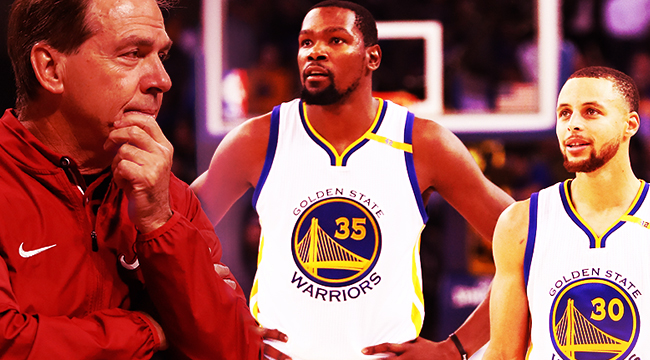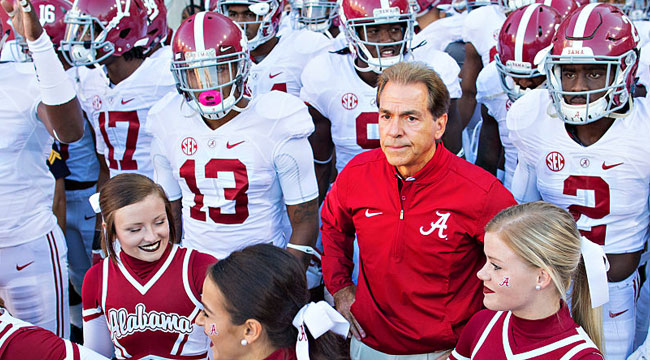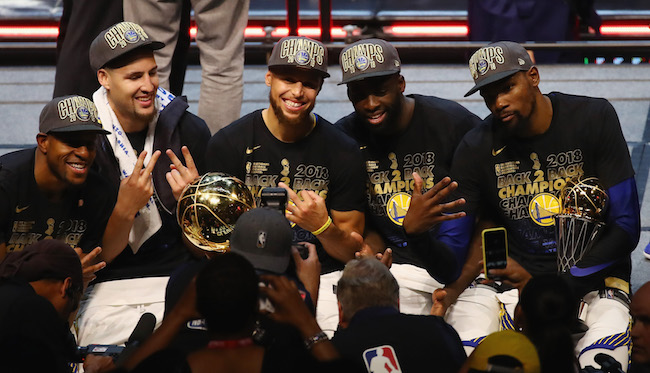
The Atlanta Hawks have set off upon the unenviable task of rebuilding from the ground up. Within the past four years, the Hawks have brought in a new CEO, new ownership, a new general manager, a new coach, and a completely new roster.
Kent Bazemore is the only member of the Hawks that has seen playoff action in Philips Arena, and it wouldn’t be all that surprising if he were dealt at some point in the next calendar year. A full rebuild is tricky, as it requires a complete amount of trust from top to bottom in the vision of those executing the roster’s construction.
The man in charge of Atlanta’s rebuild is Travis Schlenk, formerly the assistant general manager of the Golden State Warriors during their ascension into becoming the NBA’s elite franchise. Unsurprisingly, his vision is to try and replicate the process that he helped oversee in the Bay that led the Warriors on their upward trajectory. SB Nation’s Tom Ziller recently offered a look at just how Schlenk was going about trying to follow Golden State’s blueprint in Atlanta, starting with the controversial decision to trade down and draft Trae Young with the fifth pick in the 2018 NBA Draft.
It’s a good read that points out how Schlenk is starting by attempting to load up the roster with shooters, emulating the depth of shot-makers that has been the trademark of the Warriors run. However, history tells us that trying to follow the blueprint of a dynasty rarely pans out as creating a “2.0” version of that franchise and instead produces something of a cheap alternative. The Hawks, if they do truly try to build a roster in the image of Golden State, are more likely to become the Costco Warriors than they are another version of Warriors 2.0, complete with the success that has made them a dynasty.
Every major sports league, at the collegiate and professional level, is a copycat league. Whatever works for one team, propelling them into the strata of the elite, is bound to be emulated by others, but the best franchises and programs know to balance following the trend with finding unique ways to combat them.

The best example of this comes from college football, where Alabama has lorded over the SEC and the rest of the country for nearly a decade under Nick Saban. The Crimson Tide have become a juggernaut, consistently at the top of the rankings (both in recruiting and on-field success), and many programs in the SEC have fallen prey to the trap of trying to replicate the Tide in order to beat them. Trying to beat Alabama at what Alabama does best is the college football equivalent of getting involved in a land war in Asia. It simply doesn’t work.
Saban and his staff will almost always recruit better players than you, particularly those players that do the things they do best. Even so, teams continue to hire Saban acolytes in hopes that they’ll be able to out-Saban Saban, which is, in turn, a fool’s errand. The teams that have found the most success going head-to-head against the Tide in recent years have been Auburn, Ole Miss (albeit in a brief stretch that was a controversial blaze of glory), and Clemson.
All three of those programs have had differences in the specifics of how they’ve gone about attacking Alabama, but all share certain through-lines. Clemson and Auburn in particular have weaponized having a mobile quarterback in a way that has consistently frustrated Saban defenses, because it’s impossible to prepare for extended and broken plays. Ole Miss provided a similar unpredictability and a damn the torpedoes approach to simply slinging the ball downfield against Alabama’s vaunted secondary, utilizing their tremendous size and speed on the perimeter.
The worst way to attack Alabama is to try and be Alabama.
LSU consistently has rammed its head into the brick wall that is the Tide’s defensive front to no avail, despite having otherworldly talent at all the requisite positions across the offensive line and in the backfield. Alabama’s talent will almost always win out, because their depth chart goes three-deep with five-star talent (that is also getting the best internal development to fulfill their potential), but the Tide are also always evolving. There are certain things that are just foundational at Alabama, like great line play on both sides of the ball, but the rest is always adapting to how college football is shifting around them, which is part of what makes replicating the Tidenearly impossible.
There’s just no real way to match everything that Alabama has, from talent (consistently bringing in the top recruiting class in the nation), to coaching, to just the general trust and buy-in to “the system” that Saban is able to get from everyone that walks through the doors in Tuscaloosa. And if you manage to come close to all of those things and have figured out how to do what they did on the field, you’re probably a year or two behind in what Alabama is actually doing now, and thus, you’re being passed by anyways.

Like with Alabama, replicating the Warriors blueprint is an impossible task. They are the confluence of so many things that required tremendous luck. Golden State is the perfect storm of draft picks, player development, contract and salary cap luck, and, similar to Alabama, institutional buy-in to a system from everyone from the top down.
That’s not to say there aren’t things to learn from Golden State and pieces to try and clone. It’s hard to argue against the idea of filling a roster with shooters. Although the catch here is that the Warriors have managed to find shooters that can, for the most part, also play very good defense, and their one marksman who isn’t a great defender is the best shooter to ever play the game. If you can find four All-Stars that fit together just about perfectly and are willing to accept their roles within the team, you should definitely do that, too, but the idea that there’s a “blueprint” to doing so is almost laughable.
With Golden State, the best things to replicate are broader ideals: Draft extremely well, have a player development program capable of transforming top prospects into bonafide stars, instill a culture of winning, and make savvy free agency signings to fill out the roster. You could say just about the same things with Alabama football, swapping in “recruit” for “draft” and “free agency,” but within those attributes (which are hallmarks of most any good team) you need to figure out what works for your program in particular.
Finding the next Steph Curry or Draymond Green or Klay Thompson or Kevin Durant is likely going to be a less than fruitful venture, and trying to create a team modeled specifically after the roster construction of the Warriors is impossible for so many reasons. The team that’s done the best job of replicating the Warriors blueprint is the Celtics. A team that’s drafted extremely well, developed those players internally, signed supplemental stars in free agency, and gotten complete and total buy-in to “the system” from the entire team. You’d be hard-pressed to find many folks saying Boston tried to be the Warriors 2.0, though, because while they’re in the process of doing all those things the Warriors did, they are doing so in a way that is unique to them.
Nothing Golden State has done from a macro sense is new to the construction of a great franchise or program. They’ve gotten to the point they are through a combination of identifying talent, developing it, creating a culture where players want to play, and, frankly, some significant luck to put them in that position.
At Alabama, it’s a similar confluence of factors that’s created their juggernaut, and the teams that have had the most success against them (and/or simply elsewhere in the college football world) do those same broad things well and have found ways to maximize the talent they bring in. Even Georgia, considered to be the “next Alabama” in college football circles with Saban’s large adult son Kirby Smart at the helm, understands it’s not about trying to force a Nick Chubb or Sony Michel into being Mark Ingram or Trent Richardson, because Alabama doesn’t ask its players to be anyone else but the best versions of themselves. Instead, they’re simply recruiting better than anyone in the country (including Saban and Alabama) and trying to build a foundation and identity of their own (that certainly has ties to that in Tuscaloosa, but is in itself unique) that is capable of long-lasting success.
You don’t become Alabama 2.0 or the Warriors 2.0 or the Patriots 2.0, because they are all unique in how they came to be the best and most dominant. You simply follow the basic team-building principles that all great franchises have and hope that you are able to luck into some generational talent along the way.
Of all the teams in the NBA to understand this, it should be the Hawks, whose efforts at being “Spurs East” resulted in the Diet Spurs, a team of very good players that played very well together but were simply incapable of getting past the league’s elite that has been blown up in favor of the latest copycat mission. Instead, in an effort to disrupt, it seems like they’re gunning for Warriors 2.0, and they might run the risk of getting stuck in beta.






